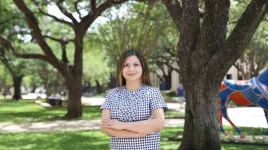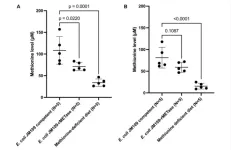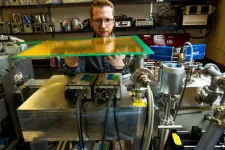(Press-News.org) A University of Texas at Arlington faculty member is pioneering a transformative technique aimed at enhancing the utilization of tungsten in additive manufacturing processes, specifically overcoming significant challenges presented by tungsten’s high melting point, intrinsic brittleness and high susceptibility to cracking.
Narges Shayesteh, assistant professor in the Mechanical and Aerospace Engineering Department and director of the Innovative Additive Manufacturing Laboratory, has earned a five-year, $582,358 Faculty Early Career Award Development Program (CAREER) grant from the National Science Foundation to advance her research and education initiatives.
The CAREER Award is the NSF’s highest honor for junior faculty. Winners are outstanding researchers, but also are expected to be outstanding teachers through research, educational excellence and the integration of education and research at their home institutions.
“This is a truly prestigious honor for me,” Shayesteh said. “It provides a significant chance to expand and enhance my ongoing research in this crucial area.”
Refractory metals, especially tungsten, are known for their high strength and high melting temperatures and hold immense potential for applications in extreme environments, like those found in space and defense. But their inherent brittleness and high susceptibility to cracking present significant hurdles for use in fabrication.
Shayesteh aims to overcome these obstacles and enhance the performance and heat tolerance of tungsten. Her innovative research focuses on a unique hybrid manufacturing technique that combines in-situ rolling and nanoparticle sealing during the laser powder-bed fusion of tungsten parts. In this intricate process, each layer of tungsten is attentively subjected to rolling during its solidification stage, helping to fine-tune its grain structure and decrease the likelihood of crack formation. Afterward, a layer of tungsten nanoparticles is applied and melted, effectively sealing any potential cracks.
“Addressing the manufacturing complexities of tungsten parts is not straightforward, but my unique hybrid technique holds substantial promise,” Shayesteh said. “My research could yield wide-ranging benefits, such as improving components for hypersonic aircraft and unique fusion reactors, thereby enhancing national security and contributing to the U.S. economy.”
Erian Armanios, chair of the Mechanical and Aerospace Engineering Department, said Shayesteh’s grant is an example of groundbreaking research by UTA researchers.
“Dr. Shayesteh’s CAREER Award is a feather in her cap, and an excellent reflection of UTA’s research and innovation,” he said. “Her discoveries will support our leading work in hypersonics, as well as in many other areas.”
Written by Jeremy Agor, College of Engineering END
A prestigious CAREER award for UTA faculty member
UTA manufacturing expert Narges Shayesteh earns National Science Foundation award
2023-06-27
ELSE PRESS RELEASES FROM THIS DATE:
DNA barcoding identifies the plants a person has eaten
2023-06-27
DURHAM, N.C. – What people say they’ve eaten and what they’ve actually eaten are often two very different lists of foods. But a new technique using DNA barcoding to identify the plant matter in human feces may get at the truth, improving clinical trials, nutrition studies and more.
Building on earlier studies that attempted to compare DNA found in feces with reported diets, researchers in the lab of Lawrence David, an associate professor of molecular genetics and microbiology in the Duke ...
Methionine restriction reverses old-age obesity in mice
2023-06-27
“This is the first report that showed the efficacy of methionine restriction to reverse old-age-induced obesity.”
BUFFALO, NY- June 27, 2023 – A new research paper was published in Aging (listed by MEDLINE/PubMed as "Aging (Albany NY)" and "Aging-US" by Web of Science) Volume 15, Issue 11, entitled, “Old-age-induced obesity reversed by a methionine-deficient diet or oral administration of recombinant methioninase-producing Escherichia coli in C57BL/6 mice.”
Obesity increases with aging. Methionine restriction ...
The 2023 Ogawa-Yamanaka Stem Cell Prize awarded to Magdalena Zernicka-Goetz
2023-06-27
SAN FRANCISCO, CA—Magdalena Zernicka-Goetz, PhD, was announced today as the recipient of the 2023 Ogawa-Yamanaka Stem Cell Prize by Gladstone Institutes. Zernicka-Goetz is a professor of mammalian development and stem cell biology in the Department of Physiology, Development, and Neuroscience at the University of Cambridge, as well as the Bren Professor of Biology and Biological Engineering at the California Institute of Technology.
A pioneering stem cell scientist, Zernicka-Goetz was selected for the prize because of her work uncovering fundamental mechanisms that drive the development of mammalian embryos, which led to the ...
Unsafe feeding methods spiked during infant formula shortage
2023-06-27
Nearly half of parents who relied on formula to feed their babies during the infant formula shortage last year resorted to potentially harmful feeding methods, according to a survey from researchers at the University of California, Davis. The study was published in the journal BMC Pediatrics.
In an online anonymous survey of U.S. parents, the number of individuals that used at least one unsafe feeding practice increased from 8% before the formula shortage to nearly 50% during the shortage. Unsafe practices included watering down formula, using expired or homemade formula, or using human milk from informal sharing.
The percentage of parents who shared human milk ...
Illinois study reveals genetic secrets of America's favorite snack
2023-06-27
URBANA, Ill. – In its simplest form, popcorn is pretty uncomplicated. Most supermarket varieties offer the choice of two kernel colors, yellow or white, and two kernel shapes, pointed or pearl. When popped, the flake typically expands into one of two shapes: mushroom or butterfly. But there’s more to popcorn than meets the eye. New research from the University of Illinois Urbana-Champaign reveals a wealth of untapped diversity lurking in popcorn’s genetic code.
Analyzing 320 publicly available popcorn lines, crop sciences researchers found variation at more ...
UC Irvine scientists develop freely available risk model for hurricanes, tropical cyclones
2023-06-27
Irvine, Calif., June 27, 2023 — As human-driven climate change amplifies natural disasters, hurricanes and typhoons stand to increase in intensity. Until now, there existed very few freely available computer models designed to estimate the economic costs of such events, but a team of researchers led by Jane W. Baldwin at the University of California, Irvine recently announced the completion of an open-source model that stands to help countries with high tropical cyclone risks better calculate just how much those storms will impact their people and their economies.
“Tropical cyclones are some of the most impactful natural disasters on Earth. They pose huge risks ...
New model provides unprecedented window into human embryonic development
2023-06-27
Two to three weeks after conception, an embryo faces a critical point in its development. In the stage known as gastrulation, the transformation of embryonic cells into specialized cells begins. This initiates an explosion of cellular diversity in which the embryonic cells later become the precursors of future blood, tissue, muscle, and more types of cells, and the primitive body axes start to form. Studying this process in the human-specific context has posed significant challenges to biologists, but new research offers an unprecedented window into this point in time in ...
Deaf mice can have virtually normal auditory circuitry: implications for cochlear implants
2023-06-27
Researchers at Johns Hopkins University, US, led by Calvin Kersbergen report that mice with the most common form of human congenital deafness develop normal auditory circuitry – until the ear canal opens and hearing begins. Publishing June 27th in the open access journal PLOS Biology, the study suggests that this is possible because spontaneous activity of support cells in the inner ear remains present during the first weeks of life.
Mutations to the protein connexin 26 are the most common cause of hearing loss at birth, accounting for more than 25% of genetic hearing loss worldwide. To understand how these mutations lead to deafness ...
Deaf mice have nearly normal inner ear function until ear canal opens
2023-06-27
**EMBARGOED TILL TUESDAY, JUNE 27, AT 2 P.M. ET**
For the first two weeks of life, mice with a hereditary form of deafness have nearly normal neural activity in the auditory system, according to a new study by Johns Hopkins Medicine scientists. Their previous studies indicate that this early auditory activity — before the onset of hearing — provides a kind of training to prepare the brain to process sound when hearing begins.
The findings are published June 27 in PLOS Biology.
Mutations in Gjb2 cause more than a quarter of all hereditary forms of hearing loss at birth in people, according to some estimates. The connexin 26 protein coded by ...
Chemists are on the hunt for the other 99 percent
2023-06-27
The universe is awash in billions of possible chemicals. But even with a bevy of high-tech instruments, scientists have determined the chemical structures of just a small fraction of those compounds, maybe 1 percent.
Scientists at the Department of Energy’s Pacific Northwest National Laboratory (PNNL) are taking aim at the other 99 percent, creating new ways to learn more about a vast sea of unknown compounds. There may be cures for disease, new approaches for tackling climate change, or new chemical or biological threats lurking in the chemical universe.
The work is part of an initiative known as m/q or “m over q”—shorthand ...
LAST 30 PRESS RELEASES:
Why nail-biting, procrastination and other self-sabotaging behaviors are rooted in survival instincts
Regional variations in mechanical properties of porcine leptomeninges
Artificial empathy in therapy and healthcare: advancements in interpersonal interaction technologies
Why some brains switch gears more efficiently than others
UVA’s Jundong Li wins ICDM’S 2025 Tao Li Award for data mining, machine learning
UVA’s low-power, high-performance computer power player Mircea Stan earns National Academy of Inventors fellowship
Not playing by the rules: USU researcher explores filamentous algae dynamics in rivers
Do our body clocks influence our risk of dementia?
Anthropologists offer new evidence of bipedalism in long-debated fossil discovery
Safer receipt paper from wood
Dosage-sensitive genes suggest no whole-genome duplications in ancestral angiosperm
First ancient human herpesvirus genomes document their deep history with humans
Why Some Bacteria Survive Antibiotics and How to Stop Them - New study reveals that bacteria can survive antibiotic treatment through two fundamentally different “shutdown modes”
UCLA study links scar healing to dangerous placenta condition
CHANGE-seq-BE finds off-target changes in the genome from base editors
The Journal of Nuclear Medicine Ahead-of-Print Tip Sheet: January 2, 2026
Delayed or absent first dose of measles, mumps, and rubella vaccination
Trends in US preterm birth rates by household income and race and ethnicity
Study identifies potential biomarker linked to progression and brain inflammation in multiple sclerosis
Many mothers in Norway do not show up for postnatal check-ups
Researchers want to find out why quick clay is so unstable
Superradiant spins show teamwork at the quantum scale
Cleveland Clinic Research links tumor bacteria to immunotherapy resistance in head and neck cancer
First Editorial of 2026: Resisting AI slop
Joint ground- and space-based observations reveal Saturn-mass rogue planet
Inheritable genetic variant offers protection against blood cancer risk and progression
Pigs settled Pacific islands alongside early human voyagers
A Coral reef’s daily pulse reshapes microbes in surrounding waters
EAST Tokamak experiments exceed plasma density limit, offering new approach to fusion ignition
Groundbreaking discovery reveals Africa’s oldest cremation pyre and complex ritual practices
[Press-News.org] A prestigious CAREER award for UTA faculty memberUTA manufacturing expert Narges Shayesteh earns National Science Foundation award






